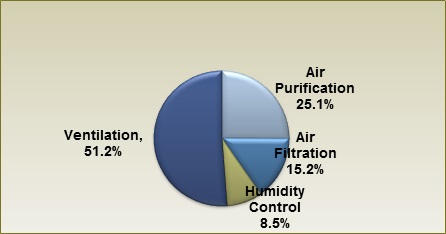by Frost & Sullivan Research Analyst Aanchal Singh — July 2016 — Air quality, in general, is at the forefront of the public’s consciousness. The need for indoor air quality (IAQ) at the facility management level is soaring and trending upward. According to the American Academy of Allergy, Asthma & Immunology, an estimated 1.9 million cases of asthma among adults were work-related, accounting for 15.7% of current adult asthma cases.[1] Additionally, according to the US Department of Energy, analysis indicates that there can be up to a “6 percent improvement in productivity with an improvement of IAQ.”[2]
Growing concern over IAQ and proper ventilation for occupants has pushed regulatory bodies such as the American Society of Heating, Refrigerating, and Air-Conditioning Engineers (ASHRAE) to recommend and implement stringent standards for facilities to maintain accurate ventilation levels for human comfort. Frost & Sullivan analysis indicates that facility management teams are required to carefully plan dehumidification and IAQ system installations that maintain the relative humidity level of less than 65%.
Improving comfort and well-being of building occupants will have a positive impact on their productivity and wellness, which will translate into fewer sick days. According to Frost & Sullivan, creating a comfortable IAQ atmosphere is a pillar of the sustainability movement, which is at the core of what facility executives do every day. Some measures recommended improving IAQ and simultaneously reducing energy consumption, including the following: IAQ requirements are dictated by regulatory guidelines that enforce increased focus on ventilation, IAQ, and occupant comfort. Both the Canadian and United States governments have encouraged the growing focus on air quality inside a facility. Below are the standards and ratings that facility managers have to comply with in order to achieve and sustain IAQ in occupied spaces.
| STANDARD & RATINGS | DESCRIPTION |
|
ASHRAE 90.1 (2013)[3]
|
Energy Standard for Buildings Except Low-rise Residential Buildings |
|
ASHRAE 189.1 (2014)
|
Standard for the Design of High-performance Green Buildings |
| ASHRAE 62.1 | Ventilation for Acceptable Indoor Air Quality |
| ASHRAE 170 | Ventilation of Health Care Facilities. It is a mandatory requirement for minimum ventilation design in health care facilities. |
| LEED (Indoor Environmental Quality- IEQ Rating) |
Achieving IAQ has the potential to generate rating points in five of the major categories (i.e., Water Efficiency, Energy and Atmosphere, Materials and Resources, Indoor Environmental Quality, and LEED Innovation Credits). |
Source: Frost & Sullivan
Facility executives can collaborate with the HVAC manufacturers to establish more robust equipment across facilities to avoid sick building syndrome. There are various methods with which facility managers can achieve a more ventilated space. Some of these methods are air purification, ventilation, air filtration, and humidity control. According to Frost &Sullivan, the North American IAQ equipment market has experienced an increased push from the regulatory bodies toward the adoption of IAQ equipment in their facilities to maintain an ideal occupant comfort zone. The demand for IAQ equipment has risen in the past 10 years. The percentage breakdown between revenues by product segments depicted below suggests that efforts are increasing to create a total solution that can monitor IAQ across facilities. [4]
The market for ventilation is by far the biggest revenue maker between the HVAC air filters market, air purification markets, and humidity control equipment markets. It accounts for 51.2% of the total IAQ market in North America, followed by air purification. A key driver for ventilation is the increase construction of air-tight building envelopes, which demand better ventilation of airflow. Of the 1.5 million buildings within the United States having more than 10 occupants, most are required to conform to the ventilation requirement set by the ASHRAE standards. Additionally, the use of air filters is required to pre-treat outside air that flows indoors. This is an essential process to fight all contaminants that may harm the overall well-being of an occupant. Humidity control is an increasingly important aspect of a facility operation. Managers are required to carefully plan dehumidification system installations that maintain the relative humidity level of less than 65%.
In order to be compliant with the regulatory standards, facility executives can follow a strategic plan to implement robust guidelines for integrating strong IAQ management into their facilities’ maintenance and operation (O&M) agendas. Some of the essential requisites of the plan are[5]:
- Review HVAC design and O&M plans and documentsàConduct a walkthrough inspection of the facility (check occupancy and equipment status). This also consists of understanding airflow directions or pressure differentials in significant areas.
- Collect detailed informationà Gather records on pollutant pathways and sources, control settings and operating schedules.
- Review complaint recordsà Keep track of locations that need monitoring or correction, and identify areas that require immediate attention.
Facility managers are becoming more aware of the IAQ problems. The executives can leverage the IAQ products in the market and follow regulatory guidelines to better manage the maintenance and operations of the overall internal environment of the space.
[1] Centers for Disease Control and Prevention. Work-related Asthma in 22 States. Morbidity and Mortality Weekly Report 2015; 64: 13: 343.
[2] Department of Energy
[3]American Society of Heating, Refrigerating, and Air-Conditioning Engineers (ASHRAE)
[4] Frost & Sullivan Research, “Strategic Analysis of the North American Indoor Air Quality (IAQ) Markets.”
[5] US Environmental Protection Agency, “Building Air Quality, A Guide for Building owners and Facility Managers.”
